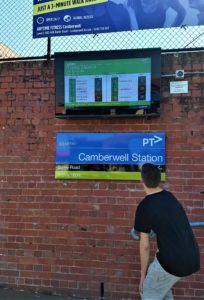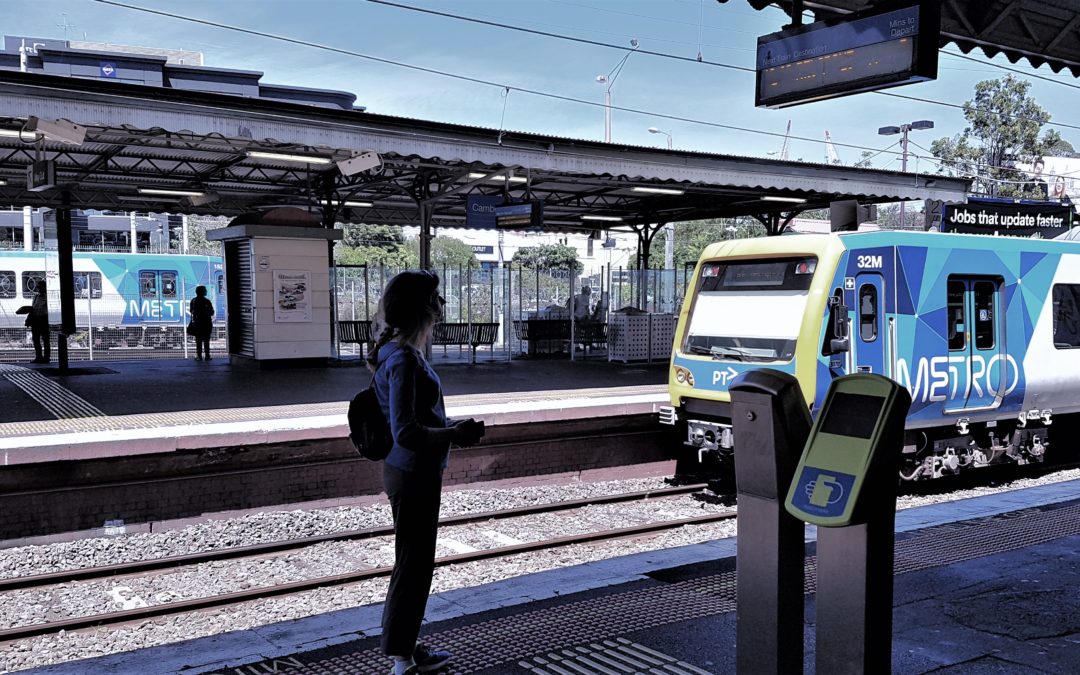Did you watch Elon Musk’s Tesla space launch the other day? Way to travel!! Back on frontier Earth, it seems technology still can’t overcome transport problems we’re living with now. For many among us, who will always rely on public transport to get from A to B, transport remains remote, risky and unnavigable.
What does my head in is the basic stuff we’re not getting right. Destination boards, for instance. It’s not rocket science that everyone benefits from clear, large, frequently placed signs. But on Melbourne public transport, they’re often high, with small print on a dark background. Almost impossible for a short person with poor vision to read.
Which brings me to my daughter. I’ve chronicled some of the plethora of issues she’s gradually been overcoming and managing as we seek to empower her to become an independent traveller. Although her travel is restricted to a very limited range of routes and destinations, we’ve been encouraged by her growing confidence as she gradually increases the number of successful trips.
I also like to think that by travelling independently, this young lady helps to spread awareness that people with special needs are getting out and about in the community, being involved, learning, enjoying life like anyone else.
Just when you think it’s safe to get back on the tram…
My daughter’s confidence was significantly shaken after a scare getting off the tram, when a car drove straight through the stop. At least she wasn’t hurt. However, inwardly I was groaning at the thought of so many months of work potentially undone by one driver’s carelessness.
One slip on the gravel edge of a country road while bike riding two years ago is still affecting her willingness to get back on a bike. How would this near miss affect her independent travel?
Well, to my surprise and delight, with encouragement and the promise of a milkshake, she was ready to get back on the tram. For my own peace of mind though, I feel that I must meet her at any tram stop without an adjacent pedestrian light.
I don’t know who was more nervous, her or me, as she set off on that first journey post-near-miss. However, a successful completion was a confidence booster for both of us.
Onwards and upwards! How wonderful that she is so motivated in her quest to travel independently.
The role of routine
While routine helps any of us, it is especially necessary for my autistic daughter. In her last few weeks of Year 12, her travel routine became one week on the school bus, one week independent travel.
It was all or nothing. If I needed to pick her up after school, then she refused to take the tram that morning. So we needed to create another routine – the one where it was okay to go only one way on public transport.
And she succeeded, adding to the total of changes in her routine that she was slowly learning to manage.
Managing the ‘things’ thing
Despite all the practice and successful trips, we needed to stay vigilant. Meeting her at the stop wasn’t just a matter of waiting for the tram. It also involved looking in the tram to spot whether she was on it. On two occasions, she was standing at the door, ready to get off, and the tram just didn’t stop. Had she not pulled the cord? Or not pushed the buttons strongly enough?
She couldn’t tell me, but at least she had sufficient confidence in herself and her surroundings to get off at the next stop, and walk back – in the correct direction. Win!
On another occasion, though, I saw that she wasn’t even ready to get off at the right stop. I quizzed her about this and she said, “The tram was wrong! They said the wrong stop!”
Somehow the stop announcements had gone out of sequence. She had been relying solely on the announcements to identify her stop, not looking out the window to double-check where she was. So inevitably, she missed her stop. It was a good opportunity to remind her that she needed to use her eyes and ears while using public transport.

My oldest boy gets down to his sister’s height to demonstrate the difficulty of seeing and reading signage in Melbourne’s public transport system.
Lastly, she is VERY slow in checking for cars as she gets off the tram (exacerbated by poor vision and extra caution after her near miss). However, this once led to the tram starting to close its doors while she was still on the bottom step, peering out at the waiting cars. How closely was that tram driver looking, I wondered?
Dealing with the “what ifs”
In the middle of year 12, my girl had an unexpected trip to hospital, courtesy of a bout of gastro. She has a life-threatening medical condition and, like many others with special needs, a common bug that others shrug off can mean hospitalisation for her. This one laid one of her brothers low for a day. But barely an hour after the first vomit, she was in an ambulance heading to emergency. She was too weak to move and too heavy for me to carry to our own car.
The spectre of “what if…?” returned to haunt me.
“What if” she suddenly became unwell on the way to the tram stop and collapsed? What then? With her limited communication skills, she mightn’t – probably couldn’t – communicate what was wrong and what she needed. Would she be seen? Would someone stop to help her? Would they see her Mediband? Would… What if… And then, how guilty would I feel?
“What ifs” can be helpful when preparing contingency plans. They’re unhelpful when they cripple you and stop you from achieving your potential.
I’ve seen the distressing results of anxiety holding back two of my boys at different times. It’s hard stuff. Our minds say “what if…” for a reason. However, as the saying goes, a ship in the harbour is safe – but that’s not what ships are built for. When I see the joy and excitement on my daughter’s face, and her pride at being able to do what so many others her age do and take for granted, I have to manage my own “what if” challenge.
Which I needed to, the other day, when my daughter took the wrong train to her post-school program.
Signs and announcements not doing what they’re supposed to do
My independent traveller had walked to the station with her father that day. Having checked the signage, he was confident that she’d be fine getting to her program, as the next two trains scheduled were on the right line for her stop.
So when the phone rang, I thought she was calling to let me know she had arrived.
Not so.
“The announcements were too soft.” Uh-oh. That didn’t sound good.
“Are you at B and B?” I asked.
“No,” was the succinct but not terribly informative reply. At least she phoned me. Awesome! But… did she know where she was?
“Where are you?”
She told me – yay for that. I knew where to go, and asked her to wait. Then I tried calling back to let her know I was on my way, only to have the phone ring out. Drat – the volume must have been on silent. It’s been a major effort to get her to turn the phone on when she leaves the house. Since she doesn’t hear when we call or text her, the current “phone” battle is to get her to leave the volume turned up. The safety aspect of her phone ownership is only being partially fulfilled.
I never quite found out why she took the wrong train. Two consecutive trains must have been cancelled. So, more training is needed, to remind her to check the signs that announce the next train. Use your eyes AND your ears, as I so often tell her.
Yet even there, it’s not so simple. Station announcements can be indistinct. Destination boards are often high, with small print, making them almost impossible for a short person with poor vision to read. Destination announcements in trams and trains can get out of sequence. Surely, our public transport providers can get this basic stuff right!
Takeouts!
- Being able to do things independently is powerful
- Teaching people to do things independently is a long game to play
- Things will go wrong. Contingency plans are vital. Develop your own. One US couple invented a wearable QR code for their son with autism. Others use tracking apps.
- Celebrate each success. A seemingly small step is usually a huge achievement, which has come on the back of many hours of patient practice from all involved.
- Work out how to manage your own “what ifs”. Teaching independence in any area of life – from tying shoelaces to travel training – is a learning experience for parents and carers, as much as for our children.
- Letting go is hard and feeling afraid and anxious is normal. It’s because we love our kids to bits, and our anxieties around our special need kids are so much greater. So…
- Let’s not be too hard on ourselves.
Until next time, happy travelling and Happy Wombatting!


